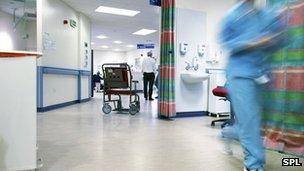A&E units on cliff edge, say NHS leaders
- Published

Pressures have been growing on A&E units for a number of years
A&E is on a "cliff edge", NHS leaders say as MPs begin an inquiry into the state of emergency care in England.
The warning by NHS Confederation chief executive Mike Farrar comes as the Health Select Committee holds its first hearing on the issue.
He said if the pressures continued to grow, the workload would become "simply impossible" to deal with.
Meanwhile, the Independent reports that A&E chiefs in the West Midlands say they can no longer guarantee safety.
In a letter sent to NHS managers across the region and seen by the newspaper, emergency care managers said they were finding themselves in a position where the delivery of unsafe care was happening on "too frequent a basis".
The latest warnings come after weeks of mounting concern.
The Care Quality Commission has already said it believes the rise in demand for A&E is unsustainable, while NHS England is carrying out a review of the problems.
Attendances have risen by 50% over the past decade, and this winter large parts of the health service started missing the four-hour waiting time target.
There have even been reports of temporary waiting areas being set up in hospital car parks and store rooms.
It has been described as the most challenging period for A&E for a decade.
'Crippled hospitals'
Mr Farrar said: "The recent headlines do not lie - the pressures are growing and we are getting closer and closer to the cliff edge.
"If we continue with this trend we will see another extra half a million patients cramming into our A&E department in the next three years.
"This will be simply impossible for our hospital services to cope with despite the heroic efforts of staff to date."
But he added: "There is no use in pointing the finger at patients, or any one part of the system, when in reality it is a perfect storm of different mounting pressures causing our problems - GPs, hospitals, [non-emergency helpline] NHS 111, the ambulance service and social care."
Dr Mike Clancy, president of the College of Emergency Medicine, said he agreed the "whole system" needed to work together.
"There is a lack of alternatives to A&E, particularly out-of-hours, and that means more people are coming to A&E."
He said A&E visits had risen by 250,000 in the past decade - the equivalent of five new units - meaning the system had reached the "limits of its tolerance".
Dr Patrick Cadigan, of the Royal College of Physicians, added the problems were also related to the increasingly complex conditions patients, many of them "elderly and frail", have.
"What appears to have crippled hospitals is there has been an increase in length of stay."
The topic was also brought up in the House of Commons.
Shadow health secretary Andy Burnham called on the government to "get a grip".
Jeremy Hunt: "Four million more people are using A&E than when [the GP] contract was changed"
"A&E is under severe pressures. People are waiting for hours to be seen on trolleys and in the back of ambulances."
Health Secretary Jeremy Hunt acknowledged A&E units were "under great pressure".
He said the government was looking to support hospitals by changing the way they were paid so they got more money for emergency admissions.
And he added in the long-term work was being done to improve integration between the NHS and social care.
But he also said a major factor in the rise in A&E attendances was the "disastrous changes" to the GP contract in 2004, which allowed them to opt out of providing out-of-hours care.
- Published21 May 2013
- Published15 May 2013
- Published1 May 2013
- Published24 April 2013
- Published14 February 2013